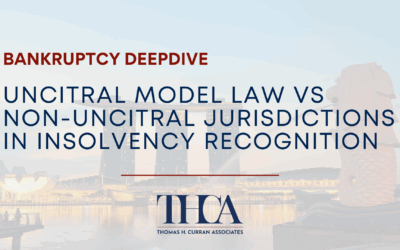Chapter 11 Business Bankruptcy Attorney
Chapter 11 bankruptcy provides viable businesses experiencing financial difficulties with the opportunity to continue operations while negotiating a plan to restructure their debt and reorganize the company to bring it back to profitability. The restructuring is accomplished through a Chapter 11 reorganization plan that, once confirmed by at least one class of creditors and the Bankruptcy Court, outlines a new contractual relationship between the debtor and its creditors.
A corporation, partnership, or limited liability company should file for Chapter 11 bankruptcy when its management believes it can return to profitability if it receives temporary protection from creditors that allows it to restructure its operations. When it is apparent that a business is no longer viable and needs to declare bankruptcy to protect the owners from creditors while winding down its operations, the best option is usually for the company to liquidate under Chapter 7 bankruptcy.
While Chapter 11 bankruptcy was traditionally considered too burdensome and expensive for small businesses to utilize, some recent changes to the U.S. Bankruptcy Code have made it easier for them to take advantage of the provision. The Small Business Reorganization (SBR) Act of 2019 added Subchapter V to Chapter 11 to simplify the proceedings for businesses with less than $2,725,625 in debt. The Coronavirus Aid, Relief, and Economic Security (CARES) Act was signed into law March 28, 2020, and temporarily raised the maximum debt for a Subchapter V bankruptcy to $7.5 million for one year.
A Chapter 11 case begins when the debtor files a petition with the Bankruptcy Court. After the filing of the petition, the debtor is protected by an automatic stay that stops all collection attempts and most lawsuits that are proceeding against the debtor. When bankruptcy is filed, the debtor usually assumes the role of the debtor in possession and serves as trustee of the bankruptcy estate throughout the proceedings. However, in some scenarios, the Bankruptcy Court may appoint a trustee to manage the bankruptcy estate.
The debtor in possession draws up and files a Chapter 11 plan with the court that lays out the substantive rights of the debtor and creditors. The plan may restructure the business in several different ways, including securing more favorable loan financing, giving lenders priority on earnings, or by rejecting and canceling contracts. If the business is insolvent, the restructuring may leave the debtor without assets and its creditors owning the reorganized company.
Bankruptcy Courts usually require that the plan be accompanied by a disclosure statement providing additional information to the creditors that allow them to make informed decisions regarding the debtor’s plan. The disclosure statement can include such items as a history of the debtor’s business operations, projections regarding the debtor’s ability to make payments under the plan, and a liquidation analysis. Small businesses may be excused from filing a disclosure statement if the court finds the plan itself contains enough information.
A bankruptcy trustee will reach out to the unsecured creditors after the filing of the Chapter 11 petition to gauge their interest in forming a Creditor’s Committee. Based on the responses of the creditors, the trustee will decide whether a committee should be formed. The Creditor’s Committee represents the general unsecured creditors and consults with the debtor’s attorney regarding such matters as the administration of the bankruptcy estate, drafting the reorganization plan, and other issues.
A reorganization plan should group similar types of debt into classes and propose that each class be repaid in the same manner. A class need not contain more than one creditor. For the Bankruptcy Court to approve a reorganization, the plan must be approved by at least one-half of the creditors that are owed at least two-thirds of the dollar amount of least one class of impaired creditors. Impaired classes are those that would receive less than full payment under the plan.
When a Chapter 11 reorganization plan is confirmed by the Bankruptcy Court judge the debtor is discharged from the debts that existed before the confirmation date and are not addressed in the reorganization plan. The debtor must repay creditors in accordance with the plan and creditors are barred from further communications with the debtor. The court may modify the plan’s provisions related to such items as payment amounts or payment timetables. The debtor’s failure to follow the plan may result in the dismissal of the case.
Upon completing the confirmed plan, the debtor must file a final report that includes such things as records of creditor payments, how the business’s assets have been administered, and any other information relevant to the closing of the case. The case is formally closed when the reorganization has been completed and a final decree issued by the court.
The attorneys of Thomas H. Curran Associates are experienced in assisting sophisticated business clients in successfully navigating Chapter 11 bankruptcy. Our skilled attorneys have helped numerous businesses with all aspects of a Chapter 11 bankruptcy, from drafting the initial petition to negotiating the reorganization plan.
Bankruptcy Practice Results
Recent successful cases handled by the attorneys from Thomas H. Curran Associates. Find more here »
Supreme Court Denies Final Appeal, Finalizing Judgement Obtained by THCA
On June 24, 2024, the Supreme Court of the United States declined the petition to review filed by Sean Dunne and his ex-wife Gayle...
Thomas H. Curran Associates Secures Appellate Victory as Massachusetts Supreme Judicial Court Denies Appellant’s Attempt to Shortcut Ordinary Appellate Review
Thomas H. Curran Associates recently obtained an appellate victory in the Massachusetts Supreme Judicial Court on May 26, 2023, in the...
Thomas H. Curran Associates win is Affirmed in Florida, U.S. District Court – Client Wins Attorneys Fees
Law: Federal Rule of Civil Procedure 37(a)(5) Case: Premier Capital, LLC v. Larry Bryan (AP) Underlying Bankruptcy Case: In re Larry Bryan...
The Second Circuit Affirms Bankruptcy Fraud Judgment Obtained by Thomas H. Curran Associates, Recognizing the Continuous Concealment Doctrine
Law: Continuous concealment doctrine, 11 USC § 727(a)(2)(A), In re Olivier, 819 F.2d 550 (5th Cir. 1987); In re Boyer, 328 F. App’x 711,...
Thomas H. Curran Associates prevails on barring discharge due to fraud by debtor
Thomas H. Curran Associates recently secured a victory on behalf of an institutional asset manager, where the Bankruptcy Court for the...
Thomas H. Curran Associates prevails on post-trial motions and obtains full security for $23 million dollar financial fraud judgment on behalf of chapter 7 bankruptcy trustee
On February 8, 2022, the United States District Court for the District of Connecticut (Meyer, J.) enter its Order denying defendant Gayle...
Supreme Court Denies Final Appeal, Finalizing Judgement Obtained by THCA
On June 24, 2024, the Supreme Court of the United States declined the petition to review filed by Sean Dunne and his ex-wife Gayle...
Thomas H. Curran Associates Secures Appellate Victory as Massachusetts Supreme Judicial Court Denies Appellant’s Attempt to Shortcut Ordinary Appellate Review
Thomas H. Curran Associates recently obtained an appellate victory in the Massachusetts Supreme Judicial Court on May 26, 2023, in the...
Thomas H. Curran Associates win is Affirmed in Florida, U.S. District Court – Client Wins Attorneys Fees
Law: Federal Rule of Civil Procedure 37(a)(5) Case: Premier Capital, LLC v. Larry Bryan (AP) Underlying Bankruptcy Case: In re Larry Bryan...
The Second Circuit Affirms Bankruptcy Fraud Judgment Obtained by Thomas H. Curran Associates, Recognizing the Continuous Concealment Doctrine
Law: Continuous concealment doctrine, 11 USC § 727(a)(2)(A), In re Olivier, 819 F.2d 550 (5th Cir. 1987); In re Boyer, 328 F. App’x 711,...
Supreme Court Denies Final Appeal, Finalizing Judgement Obtained by THCA
On June 24, 2024, the Supreme Court of the United States declined the petition to review filed by Sean Dunne and his ex-wife Gayle...
Thomas H. Curran Associates Secures Appellate Victory as Massachusetts Supreme Judicial Court Denies Appellant’s Attempt to Shortcut Ordinary Appellate Review
Thomas H. Curran Associates recently obtained an appellate victory in the Massachusetts Supreme Judicial Court on May 26, 2023, in the...
Thomas H. Curran Associates win is Affirmed in Florida, U.S. District Court – Client Wins Attorneys Fees
Law: Federal Rule of Civil Procedure 37(a)(5) Case: Premier Capital, LLC v. Larry Bryan (AP) Underlying Bankruptcy Case: In re Larry Bryan...
Bankruptcy Areas of Expertise
- Bankruptcy Litigation
- Bankruptcy Trustee Representation
- Avoidance & Recovery Actions
- Chapter 11 Trustees & Examiners
- Discharge Litigation
- Bankruptcy Fraud Investigations
- Cross Border Foreign Litigation
- 363 Bankruptcy Sales
- Bankruptcy Preference Actions
- Involuntary Bankruptcy
- Chapter 11/13 Plan Objections
Bankruptcy News
Crypto Bankruptcies and the Push for Custody Reform
The crypto sector remains under intense financial and regulatory scrutiny. The U.S. House of Representatives passed the Digital Asset...
The State of Healthcare Bankruptcy in the U.S.: Why 2025 Is a Turning Point
Jennifer Riggins sits down with Thomas Curran, Managing Partner of Thomas H. Curran Associates, to unpack the accelerating wave of...
Expanding in the Southwest: From Insolvency in Oklahoma to Asset Recovery in Texas
In this episode, Jennifer sits down with Thomas Curran, founder of Thomas H. Curran Associates, to explore the rapidly evolving world of...
U.S. Supreme Court Judgments and Global Ripple Effects
The U.S. Supreme Court has rejected Argentina’s final appeal to block an adverse ruling that allows investment funds to seize more than...
Healthcare Bankruptcies Spotlight Fraudulent Transfers
The U.S. healthcare sector is under intense financial pressure in 2025, with bankruptcies rising among private hospital groups, nursing...
UNCITRAL Model Law vs Non-UNCITRAL Jurisdictions in Insolvency Recognition
When it comes to recognizing foreign insolvency judgments, not all jurisdictions play by the same rules. Those that have enacted the...
Crypto Bankruptcies and the Push for Custody Reform
The crypto sector remains under intense financial and regulatory scrutiny. The U.S. House of Representatives passed the Digital Asset...
The State of Healthcare Bankruptcy in the U.S.: Why 2025 Is a Turning Point
Jennifer Riggins sits down with Thomas Curran, Managing Partner of Thomas H. Curran Associates, to unpack the accelerating wave of...
Expanding in the Southwest: From Insolvency in Oklahoma to Asset Recovery in Texas
In this episode, Jennifer sits down with Thomas Curran, founder of Thomas H. Curran Associates, to explore the rapidly evolving world of...
U.S. Supreme Court Judgments and Global Ripple Effects
The U.S. Supreme Court has rejected Argentina’s final appeal to block an adverse ruling that allows investment funds to seize more than...
Crypto Bankruptcies and the Push for Custody Reform
The crypto sector remains under intense financial and regulatory scrutiny. The U.S. House of Representatives passed the Digital Asset...
The State of Healthcare Bankruptcy in the U.S.: Why 2025 Is a Turning Point
Jennifer Riggins sits down with Thomas Curran, Managing Partner of Thomas H. Curran Associates, to unpack the accelerating wave of...
Expanding in the Southwest: From Insolvency in Oklahoma to Asset Recovery in Texas
In this episode, Jennifer sits down with Thomas Curran, founder of Thomas H. Curran Associates, to explore the rapidly evolving world of...
Contact Us
Are You In Need of Legal Counsel for a Bankruptcy Matter, Business Transaction, or Commercial Litigation?
Contact our team today.
Call us at (617) 207-8670 or use the quick contact form below.
Austin Office
7710 N. FM 620
Building 13-D
Austin, TX 78726
Boston Office
15 Broad Street
Suite 610
Boston, MA 02109
New York Office
305 Broadway, Suite 700
New York, NY 10007
London Office
The Leadenhall Building
Level 30
122 Leadenhall Street
London EC3V 4AB
Tags: chapter 11 business bankruptcy attorney business bankruptcy chapter 11 filing business bankruptcy chapter 11






